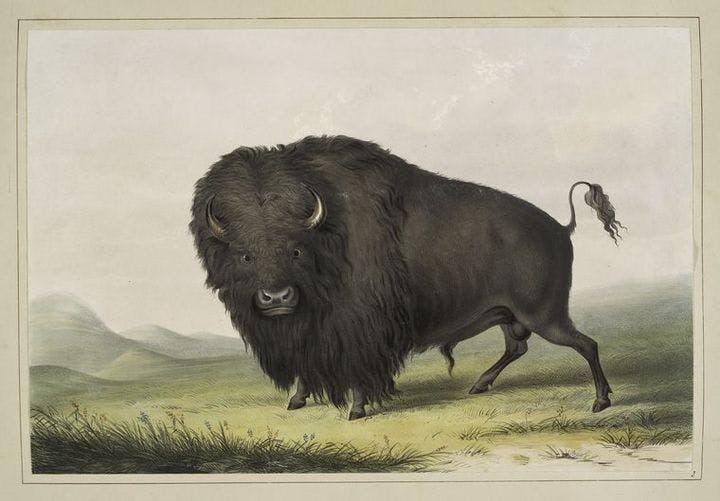Fall 2007
Animal Needs
– Brian Spak
The current plight of the American bison, which once numbered between 30 and 40 million in North America.
Human beings have always relied on plants and animals for survival, but only recently have many plants and animals begun to rely on us for theirs. Perhaps no creature exemplifies this biological role reversal better than the American buffalo.
In A Buffalo in the House, R. D. Rosen uses the story of one buffalo’s entry into the home and hearts of a southwestern couple to illustrate the current plight of wild bison. Sculptor Veryl Goodnight needs a buffalo calf to serve as a model for a piece memorializing her ancestors’ role in the survival of bison. Her husband, Roger Brooks, a retired commercial airline pilot who flew secret missions for the CIA in the 1960s, needs something more than the occasional competitive soccer game to occupy his time. And an orphaned buffalo calf needs a mother.
So Veryl and Roger fly to Idaho from their ranch on the outskirts of Santa Fe to collect Charlie, whom they name after cattleman Charles Goodnight, Veryl’s great-great uncle, who helped save bison from the brink of extinction at the turn of the 20th century. Charlie lives in the couple’s house until he reaches 400 pounds, and Roger spends many hours walking and playing with him. Months later, when Roger takes him to a ranch to live with other buffalo, Charlie has trouble adapting and injures himself running headfirst into a fence. Using the story of Charlie’s subsequent struggle for survival as a framework, Rosen recounts the tragedy of North America’s heaviest land mammal.
Bison, which are native only to North America, once numbered between 30 and 40 million in the United States and played a key role in the ecology of the Great Plains. Yet over the course of a few decades, they were nearly annihilated. By the 1830s, buffalo were virtually eliminated from the East Coast, and by the 1840s they were mostly gone from the American West. The only substantial population left roamed the Great Plains.
The re-introduction of the horse to America, improved firearms, the completion of the transcontinental railroad, and the wrath of cattle ranchers intent on protecting grazing lands all contributed to the decimation of the buffalo. And it was their misfortune that they supplied the Plains Indians with food, clothing, and shelter, making them targets for wholesale extermination by those who wished to exterminate the Indians as well. Though Meriwether Lewis had recalled seeing "innumerable herds" less than a century earlier, by the late 1880s the American buffalo was almost extinct.
More than 250,000 buffalo exist in the United States today, but only an estimated 15,000 of them live in the wild. The largest wild herd, of about 4,000, is in Yellowstone National Park, but even these animals are routinely killed by state and federal authorities, most frequently because they wander out of the park and onto grazing lands designated for cattle.
A Buffalo in the House provides an engaging history of the species and alerts readers to their current precarious existence in the wild. But the central story of Charlie and his family isn't captivating enough to sustain a booklength narrative. Much about the daily interactions between Charlie and his keepers was passed on to Rosen secondhand, and some of the drama that he saw in this story "about the outer limits of human friendship with a wild animal" is lost in his retelling.
Nevertheless, Charlie’s short life highlights the fraught relationship between humans and wildlife. Roger Brooks allowed a wild buffalo to live in his house because he loved it, an arrangement that ultimately contributed to Charlie’s untimely death. Yet such passion—balanced with careful attention to the needs of wild creatures—is necessary if the animals that have come to depend on us are to survive.
* * *
Reviewed: "A Buffalo in the House: the True Story of a Man, an Animal, and the American West" by R. D. Rosen, New Press, 2007.
Image courtesy of Wikimedia Commons
